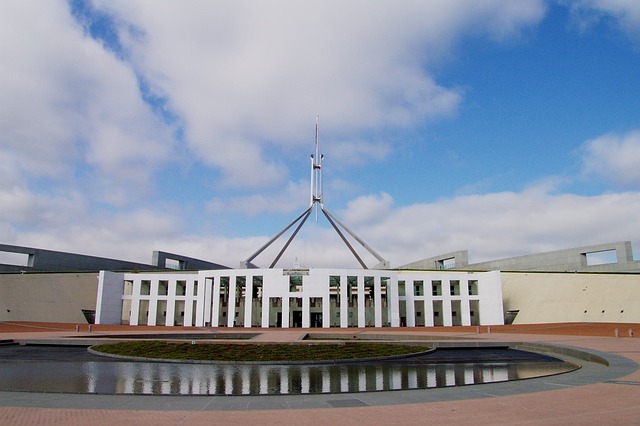By Tim Lambert
Dedicated to Hollee and Hayden Davill
Early Canberra
For thousands of years, the indigenous Ngunnawal people lived in the Canberra region, and the name ‘Canberra’ is believed to be derived from an indigenous word meaning ‘meeting place’. The first European explorers arrived in the Canberra area in 1820 and the first settlers came in 1824. During the 19th century, the European settlement slowly grew but the indigenous people were devastated by European diseases.
The Anglican Church of St John the Baptist is the oldest building in Canberra. It was built in 1845 of sandstone and bluestone. It had an adjoining schoolhouse, which is now a museum.
Another old building in Canberra is Blundell’s Cottage, which was built in 1859. It takes its name from a family who once lived there.
In 1901 the different Australian colonies formed the Commonwealth of Australia. The new country needed a capital and both Sydney and Melbourne wanted the honor. However, in 1908 it was decided to build a new capital in Canberra. A competition to design the new city was held and in 1912 American architect Walter Burley Griffin (1876-1937) won it. He planned a garden city with roads in concentric circles.
On 12 March 1913, the foundation stone of Canberra was laid by Prime Minister Andrew Fisher. However, the First World War interrupted building. Furthermore, the growth of Canberra was halted by the Depression of the 1930s. As a result, Canberra only really began to grow in the second half of the 20th century. In 1947 Canberra still only had a population of 15,000. However, by 1967 it had more than 100,000 people.
Meanwhile, Government House was built in Canberra in 1927. It is the official residence of the Governor-General. The Australian National University was established in Canberra in 1946.
The Growth of Canberra
From 1958 to 1989 the National Capital Development Commission oversaw the growth and development of Canberra. They created 4 new towns, Woden-Weston Creek, Belconnen, Tuggeranong, and Gungahlin.
Walter Burley Griffin Lake was created in 1963 by damming the Molonglo River. Captain Cook Memorial Jet was added in 1970. It sprays water 147 meters into the air. n Naturally as the seat of government Canberra is the home of many important buildings.
One of these is the Royal Australian Mint, which opened in 1965. The National Library of Australia opened in 1968. It is the largest reference library in Australia and it contains more than 5 million books. The Australian architect Walter Bunning (1912-1977) designed it. The library is also famous for its stained glass windows made by Australian artist Leonard French and tapestries by French artist Mathieu Mategot (1901-2001).
The High Court of Australia is also in Canberra. Work on the building began in 1975 and took 5 years. Its style of architecture was called ‘brutalism’. The High Court in Canberra was opened by Queen Elizabeth II in 1980. The High Court is known for its murals by Jan Sensberg.
Several famous judgments were made at the court including the Mabo judgment (1992) and the Wik judgment (1996).
Old Parliament House was built in 1927. In 1988 New Parliament House opened. Italian architect Romaldo Giurgola designed it. This huge building has 4,700 rooms. In the center is a flagpole, which is 81 meters high and weighs 2220 tonnes. Outside the entrance is a mosaic by artist Michael Tjakamarra Nelson. In the foyer are 48 grey-green marble columns meant to look like a eucalyptus forest.
The Australian War Memorial, which was built in 1941 and later enlarged contains the names of over 102,000 fallen Australians. Anzac Walk opened in 1965.
In 1970 the British gave the Australians the National Carillon.
Canberra is a thriving tourist destination. It is known for the National Museum of Australia, which was founded in 1980 and moved to its present site in 2001.
Other attractions in Canberra are the National Zoo and Aquarium and the Australian Institute of Sport, which opened in 1981. The Australian National Botanic Garden has over 5,000 species of plants. Cockington Green is a miniature British village, which opened in 1979. Looking down from the top of Black Mountain is the 195-meter-tall Telstra Tower, which opened in 1980.
Near Canberra is the Stromlo Observatory. It dates from 1924 but it was severely damaged by a bush fire in 2003 and it had to be rebuilt. n Canberra Stadium was built in 1977 and the National Gallery of Australia opened in 1982. It includes the Aboriginal Memorial of 1988 and outside the museum is a sculpture garden. Monaro Mall opened in 1963. It was redeveloped and opened as the Canberra Centre in 1989. Canberra Museum and Art Gallery opened in 1998.
21st Century Canberra

Today Canberra is a flourishing city. In recent years new amenities have been added. In 2002 Prime Minister John Howard opened Reconciliation Place. The same year he opened Commonwealth Place. In 2006 Howard opened R. G. Menzies Walk. Today the population of Canberra is 478,000.
Last revised 2025